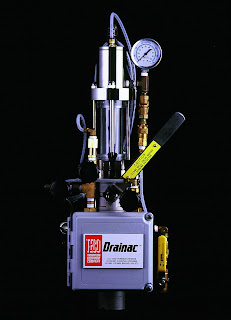So… you’re thinking about adding a Drainac to your process but you aren’t sure where to put it. There are a couple things to keep in mind when thinking about placing a Drainac, so let’s go through them now.
Let’s take a look at some of the more important tactical, physical considerations…
First, you want to find a straight length of pipe, at least seven pipe diameters long, without any bends or obstructions in the line. Why? Well, this has to do with preserving the statistics of sampling. What we want is for the stock flowing in the line to be in plug flow regime, moving along all nice, straight and even. This is important because if the stock isn’t flowing all nice and even, i.e., turbulent flow, you might get a sample of stock that isn’t necessarily representative of what’s in the line.
Turbulent flow can create things like dead spots and metastable eddies (don’t you just love that expression?) and the stock caught in those little whirlpool gems just might be from last week. And you don’t want to base your refiner loads on stock samples pulled from such places, do you? Seven pipe diameters pretty much guarantees that you’ll be in plug flow. Can you get away with smaller lengths of pipe? Sure, and some customer have successful applications in less than seven PD. But if you've got seven pipe diameters free, use 'em.
Second, make sure the line is at least six inches in diameter. This one is more of a rule of thumb than a hard, fast rule. The Drainac sample port is two inches in diameter. If you were to stick this in a four-inch line, you wouldn’t be leaving a whole lot of room for stock to flow by. That said, we have successfully installed Drainacs in four-inch lines, so it can be done. It just isn’t a first choice. I'd rather put in a six-inch spool piece, if space permits.
Here’s another rule of thumb… if you’re trying to choose between a horizontal line versus an inclined or vertical line, pick the horizontal one. This has to do with the way that a Drainac cleans itself after an analysis is completed and a horizontal line is better situated for this than an inclined or vertical line. Again, we do have successful applications in both inclined and vertical lines, so it can be done.
Fourth, and this is really important, make sure that the line is easily accessible for maintenance. The Drainac has the least maintenance requirement of any freeness analyzer, but it is not, unhappily, maintenance free. You actually have to clean it from time to time. If the system is installed in a line that’s thirty feet above the floor and you need to drag a ladder over in order to get to it, you’ll almost always find something else to do when it comes time to clean the system. If it has to be up in a pipe rack, try and find one that has a scaffold or walkway installed close by.
Fifth, make sure you have a couple of feet of head room on top of the proposed location and a couple feet of cat-slinging room from side to side. The way you clean a Drainac is to swing it open and you need room to do that. You don’t want the riser head – or your head, for that matter - banging into another pipe or a ceiling when you open the system.
Sixth, the Drainac needs both air and water, at pressures that are at least 10 psi above the maximum expected pressure in the stock line at all times. Let me repeat that, at all times. If you typically run at 40 psi, but will occasionally see 50 psi in the stock line from time to time, then both air and water should be at 60 psi, minimum, at all times. 70 psi would be better, and 80 psi better still. You get the idea.
While we're on the subject, that air supply should be instrument-quality dry air. That means a dew point of-40C or better. Wet air is bad for a Drainac as it can turn the Drainac’s precision pneumatics into boat anchors as pieces-parts get corroded.
That water supply should be filtered as well. It doesn’t have to be city water, but it should be free of particles larger than 0.007” (80 mesh). We don’t care if the water is hot or cold – it can be either. We just want it to be clean.
I have a PowerPoint - actually several of them - on this sort of stuff that I am happy to share with you at any time (webinar, anyone?). I can also send white papers, bulletins, manuals and so forth.
That covers the main tactical aspects of selecting an installation site. In my next post, I’ll talk about some of the strategic aspects.
